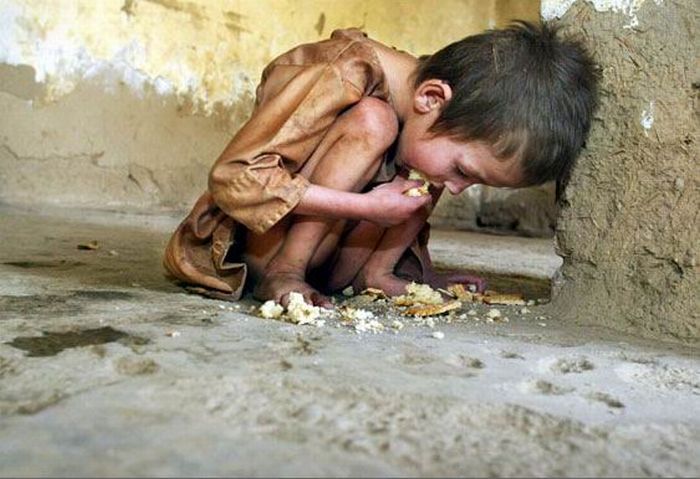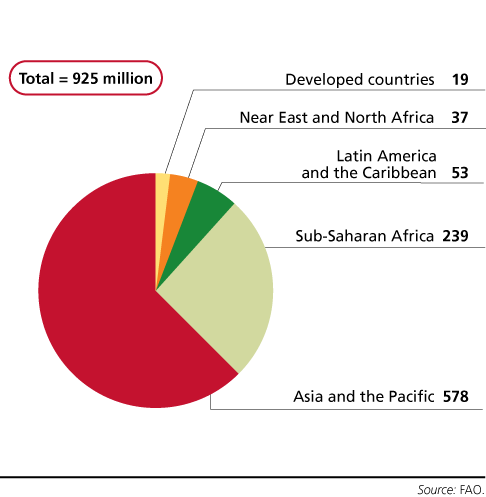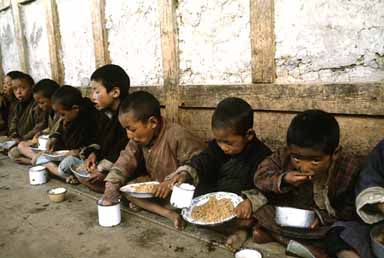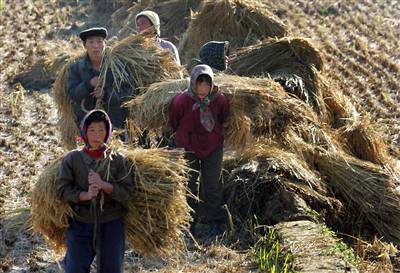One of every seven people worldwide suffer from hunger

No one really knows how many people are malnourished. The statistic most frequently cited is that of the United Nations Food and Agriculture Organization, which measures ‘undernutrition’. The most recent estimate, released in October 2010 by FAO, says that 925 million people are undernourished. The number of hungry people has increased since 1995-97, though the number is down from last year. The increase has been due to three factors: 1) neglect of agriculture relevant to very poor people by governments and international agencies; 2) the current worldwide economic crisis, and 3) the significant increase of food prices in the last several years which has been devastating to those with only a few dollars a day to spend. 925 million people is 13.6 percent of the estimated world population of 6.8 billion. Nearly all of the undernourished are in developing countries.

In round numbers there are 7 billion people in the world. Thus, with an estimated 925 million hungry people in the world, 13.1 percent, or almost 1 in 7 people are hungry.
The FAO estimate is based on statistical aggregates. It looks at a country’s income level and income distribution and uses this information to estimate how many people receive such a low level of income that they are malnourished. It is not an estimate based on seeing to what extent actual people are malnourished and projecting from there (as would be done by survey sampling).
Undernutrition is a relatively new concept, but is increasingly used. It should be taken as basically equivalent to malnutrition.
Children are the most visible victims of undernutrition. Children who are poorly nourished suffer up to 160 days of illness each year. Poor nutrition plays a role in at least half of the 10.9 million child deaths each year–five million deaths. Undernutrition magnifies the effect of every disease, including measles and malaria. The estimated proportions of deaths in which undernutrition is an underlying cause are roughly similar for diarrhea (61%), malaria (57%), pneumonia (52%), and measles (45%) (Black 2003, Bryce 2005). Malnutrition can also be caused by diseases, such as the diseases that cause diarrhea, by reducing the body’s ability to convert food into usable nutrients.
According to the most recent estimate, malnutrition, as measured by stunting, affects 32.5 percent of children in developing countries–one of three (de Onis 2000). Geographically, more than 70 percent of malnourished children live in Asia, 26 percent in Africa and 4 percent in Latin America and the Caribbean. In many cases, their plight began even before birth with a malnourished mother. Under-nutrition among pregnant women in developing countries leads to 1 out of 6 infants born with low birth weight. This is not only a risk factor for neonatal deaths, but also causes learning disabilities, mental, retardation, poor health, blindness and premature death.

The world produces enough food to feed everyone. World agriculture produces 17 percent more calories per person today than it did 30 years ago, despite a 70 percent population increase. This is enough to provide everyone in the world with at least 2,720 kilocalories (kcal) per person per day. The principal problem is that many people in the world do not have sufficient land to grow, or income to purchase, enough food. What are the causes of hunger is a fundamental question, with varied answers.
The causes of poverty include poor people’s lack of resources, an extremely unequal income distribution in the world and within specific countries, conflict, and hunger itself. As of 2008 (2005 statistics), the World Bank has estimated that there were an estimated 1,345 million poor people in developing countries who live on $1.25 a day or less. This compares to the later FAO estimate of 1.02 billion undernourished people. Extreme poverty remains an alarming problem in the world’s developing regions, despite some progress that reduced “dollar–now $1.25– a day” poverty from (an estimated) 1900 million people in 1981, a reduction of 29 percent over the period. Progress in poverty reduction has been concentrated in Asia, and especially, East Asia, with the major improvement occurring in China. In Sub-Saharan Africa, the number of people in extreme poverty has increased. The statement that ‘poverty is the principal cause of hunger’ is, though correct, unsatisfying. Why then are (so many) people poor?
The principal underlying cause of poverty and hunger could be the ordinary operation of the economic and political systems in the world. Essentially control over resources and income is based on military, political and economic power that typically ends up in the hands of a minority, who live well, while those at the bottom barely survive, if they do.
At the end of 2005, the global number of refugees was at its lowest level in almost a quarter of a century. Despite some large-scale repatriation movements, the last three years have witnessed a significant increase in refugee numbers, due primarily to the violence taking place in Iraq and Somalia. By the end of 2008, the total number of refugees under UNHCR’s mandate exceeded 10 million. The number of conflict-induced internally displaced persons (IDPs) reached some 26 million worldwide at the end of the year . Providing exact figures on the number of stateless people is extremely difficult But, important, (relatively) visible though it is, and anguishing for those involved conflict is less important as poverty (and its causes) as a cause of hunger. Using that statistics, 1.02 billion people suffer from chronic hunger while 36 million people are displaced.
By causing poor health, low levels of energy, and even mental impairment, hunger can lead to even greater poverty by reducing people’s ability to work and learn, thus leading to even greater hunger.
Climate change is increasingly viewed as a current and future cause of hunger and poverty. Increasing drought, flooding, and changing climatic patterns requiring a shift in crops and farming practices that may not be easily accomplished are three key issues.
Global warming causes 300,000 deaths a year
Hunger, the environment, and climate change
Could food shortages bring down civilization?
The target set at the 1996 World Food Summit was to halve the number of undernourished people by 2015 from their number in 1990-92. (FAO uses three year averages in its calculation of undernourished people.) The (estimated) number of undernourished people in developing countries was 824 million in 1990-92. In 2009, the number had climbed to 1.02 billion people. The WFS goal is a global goal adopted by the nations of the world; the present outcome indicates how marginal the efforts were in face of the real need.
So, overall, the world is not making progress toward the world food summit goal, although there has been progress in Asia, and in Latin America and the Caribbean.
| Region | % in $1.25 a day poverty | Population (millions) | Pop. in $1 a day poverty (millions) |
| East Asia and Pacific | 16.8 | 1,884 | 316 |
| Latin America and the Caribbean | 8.2 | 550 | 45 |
| South Asia | 40.4 | 1,476 | 596 |
| Sub-Saharan Africa | 50.9 | 763 | 388 |
| Total Developing countries | 28,8 | 4673 | 1345 |
| Europe and Central Asia | 0.04 | 473 | 17 |
| Middle East and North Africa | 0.04 | 305 | 11 |
| Total | 5451 | 1372 |
World Bank PovcalNet “Replicate the World Bank’s Regional Aggregation” (accessed May 7, 2010).

Material used in this article was taken from Hunger Notes (WorldHunger.org) and FAO




Zaida Adams commented on The Watchers:
This has been an ongoing problem. Why has a program not yet been set in place to fix this?
chillymanjaro commented on The Watchers:
Only those who would reremember to work on land, to live with Earth.The Earth behave as we misbehave! We must learn again how to grow, how to breathe with pulse of Planet, how to listen, how to let the nature feed us . We must think of those things – to be able to grown our own food and tune in with rhythms of nature. We need to bless our food daily cause everytime we feed ourselves we must be aware that somebody don’t have nothing to eat…so we must be thankfull.
MARIO commented on The Watchers:
THIS IS THE CONSEQUENCE OF THE ACTUAL MODEL OF PRODUCTION AND THE CAUSE OF THE NEXT CHANGES. BECAUSE WASTING THE RESOURCES OF THE PLANET, AT THE END LOSE THE WHOLE MANKIND. THE RULING ELITE WILL BE WASHED BY THEMSELVES!!!! BUT WHO AND HOW WILL REBUILD THE PLANET AFTER THE NEXT CHANGES………….?
stephen commented on The Watchers:
In India alone 1000’s of tons of wheat gets spoiled due to improper storage by the corrupt govt. The spoiled grains are latter used by the corrupt govt’s to make alcoholic drinks.